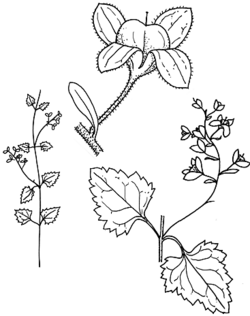Common name: Trailing Speedwell, Creeping Speedwell
Veronica plebeia R.Br. APNI* 
Description: Perennial herb, with stolons to 1 m long, flowering stems to 10 cm high; with short (c.
0.2 mm) hairs, denser in lateral bands on stems and longer and denser hairs at nodes.
Leaves with lamina triangular, mostly 0.8–2 cm long, 5–16 mm wide, apex ± acute, base truncate to slightly cordate, margins with 3–8 pairs of irregular teeth; petiole 3–20 mm long. Racemes lateral, mostly 2–5 cm long, 3–10-flowered; peduncle 5–35 cm long; bracts 3–7.5 mm long; pedicels 2–7 mm long. Calyx lobes 3.4–7 mm long, 1.3–3.7 mm wide in fruit, shortly ciliate. Corolla 2–3.5 mm long, pale lavender.
Capsule broad-obovate, 2.5–4.5 mm long and wide, slightly emarginate, sparsely pubescent to glabrous.
Flowering: spring–summer.
Distribution and occurrence: Grows in eucalypt forest, grassland, on rainforest margins and as a weed in lawns and gardens; widespread in coastal districts, west to Warrego River.
NSW subdivisions: NC, CC, SC, NT, CT, ST, NWS, CWS, NWP
Other Australian states: Qld Vic. W.A. S.A.
Text by B. G. Briggs, B. Wiecek & A. J. Whalen
Taxon concept: Flora of NSW 3 (1992)
APNI* Provides a link to the Australian Plant Name Index (hosted by the Australian National Botanic Gardens) for comprehensive bibliographic data
***The AVH map option provides a detailed interactive Australia wide distribution map drawn from collections held by all major Australian herbaria participating in the Australian Virtual Herbarium project.
|


